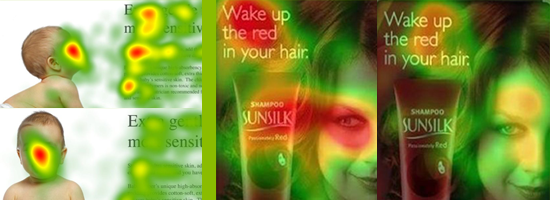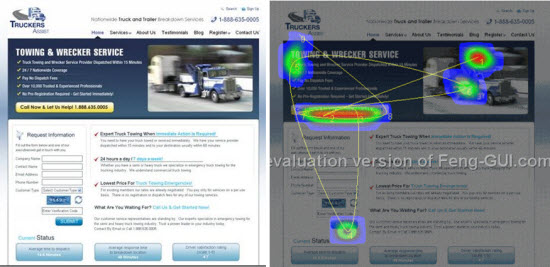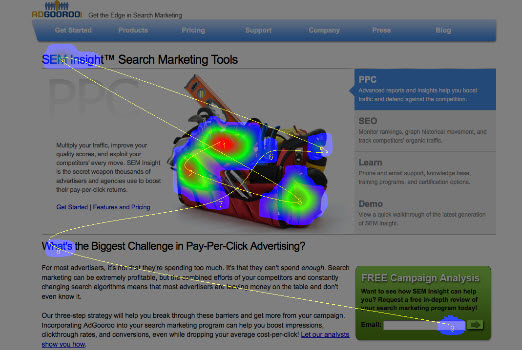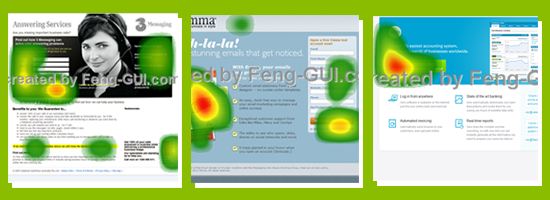There are a handful of landing page elements that never fail to draw a visitor’s attention.
If you take full advantage of these “hot spots”, you can create a more engaging landing page.
What are these hot spots?
Here are five:
#1 – The Hero Shot
The “hero shot” is a large, high quality image of your product.
In the case of services and other intangibles, the hero shot may show the ideal end result your customer desires.
In this example from Techwyse, the data from Feng-Gui, an automated attention analysis tool, shows that the hero shot draws and holds the attention of the visitor while the calls-to-action are ignored.
Changing the color of the hero shot to blue (to blend in) and the calls-to-action to yellow had the desired effect.
Notice that the hero image grabs attention but doesn’t hold it, causing the eye to move and engage with the primary call-to-action.
But automated tools like Feng Gui should be just one tool in your landing page optimization toolbox.
In this example from AdGooroo, the Feng-Gui tool determined that the hero image was holding the attention of the visitor, causing the page to perform badly.
If the story ended there, this photo would just be a distraction.
This is click data from the Crazy Egg heatmap tool on this same landing page. This data, plus analytics showing a 38% click-through on this page disprove the theory that the hero shot is distracting.

Source: AdGooroo.com, “Why we have a 38% Clickthrough Rate“
Having a hero shot by itself is a great way to attract attention, but it will mean almost nothing for your conversions if this attention isn’t directed towards action.
#2 – The First 3 Bullet Points

Images from: Marketing Sherpa
In Jakob Nielsen’s study, “F-Shaped Pattern For Reading Web Content”, readers noticed bullet points as they scanned down the left side of web pages. This makes bullet points a useful form for simply listing the features and benefits of your products.
When using bullet points, however, make sure that you don’t bury the most important features. Once you’ve identified the features and benefits that are most important to your customers, list these first. As these heatmaps from Marketing Sherpa show, visitors tend to look at bullet points in the product copy, especially the first 2 to 3 points.
#3 – White Space

Images from Strategic-planet.com, “Visually Optimise Your Websites and Adverts“
It’s tempting to fill every single pixel of your landing pages with text or graphics, but just because a space is empty it doesn’t mean that it isn’t useful.
White space or negative space helps focus your visitors’ attention on the important elements. For example, this usability study shows how the presence of margins in textleads people to read text more slowly and increases their comprehension of the text.
The use of white space may also improve the chances of having your landing page copy read. According to this study from Strategic Planet, changing a poster’s background color to white led viewers to read the text. So if you have important text that needs to be read, such as in a sales letter or landing page copy, it makes sense to test them on a white background.
#4 – The Subject’s Line of Sight

Images from Think Eye Tracking and Usable World
We are quickly drawn to human faces, especially eye gaze. Studies from Think Eye Trafficand Usable World also demonstrate that viewers look in the same direction where the photo subjects look. This means that if you’re going to add photos of human faces in your landing page, these photos will draw a lot of attention.
Redirect your reader back to the copy, call to action, or the product by directing the subject’s gaze in the same direction you would like your visitors eye to follow.
#5 – The Singular CTA
Finally, one of the major hot spots of your landing page is your most prominent call to action.
The natural eyepath of your visitors should land on this call to action if you want them to take that action.
Visitors that are trying to solve a problem are intuitively drawn to the call-to-actin. Their eyes and their clicks tend to flow towards forms, large buttons, and links. The fewer calls to action you have, and the more prominent they are on the page, the easier it will be for your visitor to find them.
Do you use any of these hot spots in your landing pages? What effect did they have on your website visitors’ actions?




























